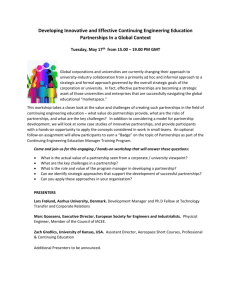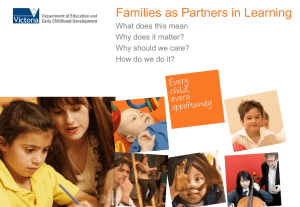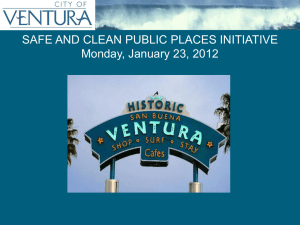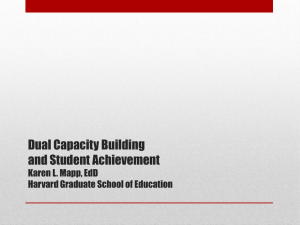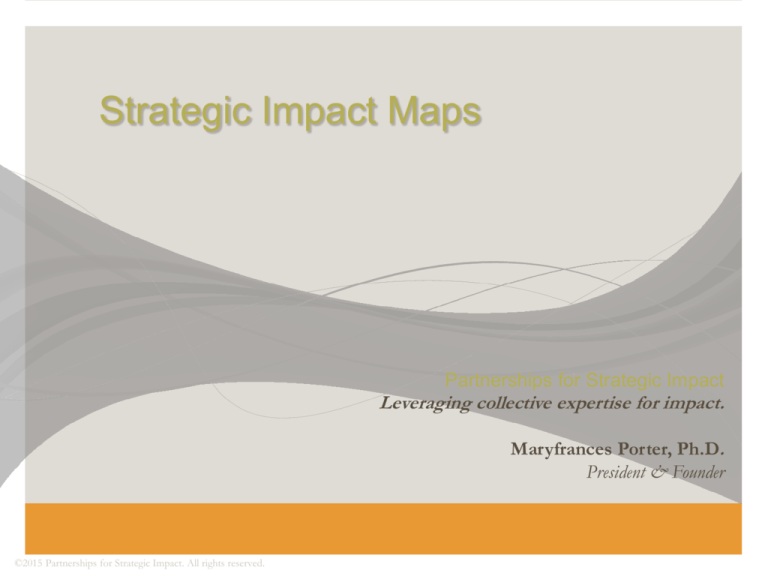
Strategic Impact Maps
Partnerships for Strategic Impact
Leveraging collective expertise for impact.
Maryfrances Porter, Ph.D.
President & Founder
©2015 Partnerships for Strategic Impact. All rights reserved.
Data Mosaics – Telling a Story with Data
Logic Models and Theory of Change
©2015 Partnerships for Strategic Impact. All rights reserved.
Logic Models
COMMONLY REQUESTED BY FUNDERS
Pros
› Picture that connects what you to the outcomes you expect to
achieve.
› Commonly used.
Cons
› Language is based on computer logic models.
› Disconnected from Strategic Planning.
› Does not inform data driven decision making.
Inputs
©2015 Partnerships for Strategic Impact. All rights reserved.
Activities
Outputs
Outcomes
Theory of Change
COMMONLY REQUESTED BY FUNDERS
Pros
› Describes why what you do is expects to result in outcomes.
› Commonly used.
Cons
› Disconnected from Logic Modeling and Strategic Planning.
› Does not inform data driven decision making.
Strategy: Provide
education to low-income
individuals wanting to
start small businesses
So That
People have the
information needed to
start small businesses
©2015 Partnerships for Strategic Impact. All rights reserved.
So That
Businesses are more
likely to succeed
So That
Low-income people have
an avenue out of poverty
› Kellogg Foundation Logic Model Development Guide
•
http://www.wkkf.org/resource-directory/resource/2006/02/wkkellogg-foundation-logic-model-development-guide
› Innovation Network Logic Model Workbook
•
http://www.innonet.org/client_docs/File/logic_model_workbook
.pdf
› Free on-line course in developing logic models
•
http://www.uwex.edu/ces/lmcourse/#
› Annie E. Casey Foundation
•
http://www.aecf.org/resources/theory-of-change/
› Center for Theory of Change
•
http://www.theoryofchange.org/what-is-theory-of-change/
Additional Resources
©2015 Partnerships for Strategic Impact. All rights reserved.
Strategic Impact Maps
©2015 Partnerships for Strategic Impact. All rights reserved.
Strategic Impact Map
CREATED BY PARTNERSHIPS FOR STRATEGIC IMPACT
› Builds off Logic Models and Theory of Change
› Language is relevant to organizations, consumer and funders
› Quickly communicates what you do, why, and to what end
› Used to guide survey development and data collection
› Used in data-driven decision making
› Used in strategic planning
©2015 Partnerships for Strategic Impact. All rights reserved.
Strategic Impact Maps show…
We want to eliminate a community need to reach a VISION.
To do this, we want implement a MISSION.
To achieve this mission will focus on achieving specific GOALS.
To reach these goals, we will offer specific ACTIVITIES, PROGRAMS & STRATEGIES.
To provide these activities, programs and strategies, we will need RESOURCES.
Our efforts will be shown by our PRODUCTIVITY.
Our success will be shown by the IMPACT on those we serve.
This will lead to COMMUNITY-LEVEL IMPACT by eliminating the community need.
©2015 Partnerships for Strategic Impact. All rights reserved.
Part 1 – Setting the Frame
Community-level
need data
MISSION
GOALS
VISION
©2015 Partnerships for Strategic Impact. All rights reserved.
COMMUNITY-LEVEL NEED DATA
› Your organization was formed in response to some observed need
in the community.
› Sometimes these need data were readily available.
Public Health Data: obesity rates, teen pregnancy rates, etc.
School Data: standardized test pass rates, graduation rates
› Sometimes a specific needs assessment was conducted
County Resident Satisfaction Survey
Gallup Poll
Survey of customers using a particular service
› Sometimes, and least desirable, the need arose from an informal
observation
The kids in our community don’t have anything to do
It’s too hard to get medical care in this town
©2015 Partnerships for Strategic Impact. All rights reserved.
COMMUNITY-LEVEL NEED DATA
› This is “the dial” that you are trying to move.
HOWEVER
› Your organization is not alone in addressing this need!
There are many other efforts to attack the problem from
different directions.
There are all sorts of things that could thwart these efforts no
matter how hard everyone work.
› Changes in the environment or community conditions
often emerge years – if not decades – after interventions
have been in place.
©2015 Partnerships for Strategic Impact. All rights reserved.
VISION, MISSION, GOALS
Vision, Mission and Goals frame the Strategic Impact Map
› Vision: How you envision the world being community
need were eliminated
Vibrant teens. Vibrant community.
› Mission: What you are going to do to advance the vision
The Music Resource Center is a safe, diverse and creative community space where teens build
interpersonal and industry skills through the universal language of music.
©2015 Partnerships for Strategic Impact. All rights reserved.
GOALS
› Goals: The specific ways you will implement your
mission to what end
creative self-expression
…provide state-of-the-art space and professional instruction for teens to express themselves
through music and dance.
personal achievement
…build one-on-one relationships and a diverse, collaborative community experience that engages teens in
setting and achieving personal and vocational goals.
community contribution
…expand opportunities for teens’ exposure, participation and appreciation of the arts that builds
community and cultural leadership.
©2015 Partnerships for Strategic Impact. All rights reserved.
GOALS
No
less than 2; no more than 5
Goals should not conceptually overlap
Often reflect programming areas (e.g., training, advocacy,
mentoring)
Can be conceptual-linked groups of services
Activities/Programs/Strategies,
Productivity and Immediate
Impact will be grouped by Goals
©2015 Partnerships for Strategic Impact. All rights reserved.
COMMUNITY NEED, VISION, MISSION, GOALS
› This sum up why you do what you do
e.g., You are working on M (Mission), by doing XYZ to achieve
change (Goals), so that N will change (Community-level Need
Data), and the world will be a better place (Vision).
› This a lot like a Theory of Change.
The next part of the Strategic Impact Map describes what you do.
©2015 Partnerships for Strategic Impact. All rights reserved.
Step 2 – Filling in the how
Community-level
need data
MISSION
GOALS
Activities/
Programs/
Strategies
(aka Activities)
Resources
(aka Inputs)
VISION
©2015 Partnerships for Strategic Impact. All rights reserved.
ACTIVITIES/PROGRAMS/STRATEGIES
› In standard logic model language, these are just called “activities”
› Activities/Programs/Strategies are the things that you do everyday
to achieve your goals with your clients – such as…
Trainings, Education Provided
Newsletters Published
One-on-One Mentoring Meetings
Social Media Posts
Job Fairs
Advocacy Efforts
› For coalitions, activities directly support the coalition, such as
meetings, newsletters to members, services or actions directed
toward the community
©2015 Partnerships for Strategic Impact. All rights reserved.
RESOURCES
› In standard logic model language, resources are called
“inputs”
› Resources include everything you are asking funders to fund,
as well as all the materials, people and technology tools you
need to get the work done (aka activities, programs and
strategies)
©2015 Partnerships for Strategic Impact. All rights reserved.
ACTIVITIES/PROGRAMS/STRATEGIES, RESOURCES
› These things sum up what you do and what you need to get it
done
› This is the day to day of operations.
©2015 Partnerships for Strategic Impact. All rights reserved.
Part 3 – Coming Full Circle
Community-level
need data
MISSION
GOALS
Activities/
Strategies/
Programs
(aka Activities)
Productivity
(aka Outputs)
Immediate
Impact
(aka Outcomes)
Resources
(aka Inputs)
Longer-term
Impact
VISION
©2015 Partnerships for Strategic Impact. All rights reserved.
PRODUCTIVITY
› In standard logic model language, productivity is called
“outputs”
› Productivity is how much work you do, e.g.,
How many clients you serve.
How many client hours delivered.
How many advocacy efforts made.
How many website hits.
How many workshop videos made and posted on-line.
©2015 Partnerships for Strategic Impact. All rights reserved.
PRODUCTIVITY
› Productivity often takes a back seat to outcomes/impact
– but it is very important for communicating…
You need to be doing a meaningful amount of work for others to feel you
are making a meaningful impact
Sometimes you are providing basic charity – then productivity is the end
of the road – there is nothing more to the impact than the number of
eye glasses you provided children (e.g., you will not have a
corresponding Immediate Outcome)
©2015 Partnerships for Strategic Impact. All rights reserved.
IMMEDIATE IMPACT
› In standard logic model language, impact is called “outputs”
› Immediate Impact reflects the most central information
needed to know if you are achieving your Goals
What are you hoping people will walk out of the door with?
› Immediate Impact is usually reflected by…
Knowledge
Skills
Abilities
Satisfaction
©2015 Partnerships for Strategic Impact. All rights reserved.
IMMEDIATE IMPACT – MEASUREMENT
› Indicators of immediate impact defines the general concept
that you want to measure
School Achievement
› Many different Outcomes may reflect the indicators immediate
impact you are working toward
School achievement outcomes: grades, standardized testing, attendance
› Each outcome may have many Data Points
Grade data points: % final A’s and B’s in English and Math
Standardized testing data points: % Pass plus Pass Advance on Math and
Reading SOL’s, by gender and grade
Attendance data points: % students, per grade, absent more than 10 days
per semester
©2015 Partnerships for Strategic Impact. All rights reserved.
LONGER-TERM IMPACT
› Longer-term impact (3 hours to 3 years later) is very expensive
to gather, and very unlikely to be found (even in academia!)
What are you hoping people will do with the knowledge, skills and
abilities they left your organization with?
› Longer-term impact is usually reflected by change in…
Behavior
Attitude
Achievement
Environment
©2015 Partnerships for Strategic Impact. All rights reserved.
LONGER-TERM IMPACT – MEASUREMENT
› Focus on one to three longer-term indicators of impact to
measure – if any
Focus on outcomes most likely to be related to your activities
e.g., if you provide help on filling out college applications, the longerterm outcome is the number of colleges applied to – not the number of
college acceptances
› Gather data from a sample (i.e., a small, random group) of
your past clients rather than trying to collect data from all past
clients
©2015 Partnerships for Strategic Impact. All rights reserved.
PRODUCTIVITY, IMMEDIATE IMPACT, LONGER-TERM IMPACT
› These things sum up the fruits of you labor – why it is
meaningful that you do what you do
› In your first year, you won’t have any data goals (i.e.,
expectations) – you’ll initially be looking to see how you did
(i.e., establishing benchmarks).
› After the first year, you may set meaningful data goals for your
organization.
©2015 Partnerships for Strategic Impact. All rights reserved.
The Strategic Impact Map conversation
An Identified Community Need leads to…
› a Vision for how the world could be better, and
› working to address that need by implementing a Mission
› that focuses on achieving specific, measureable Goals.
› To achieve these goals you decide to offer particular, high quality Activities,
Programs and Strategies, and
› find the Resources needed to make those happen.
› Your efforts are reflected by efficiently generating Productivity.
› Your success in meeting your goals is measured by the Immediate Impact of
your activities, programs and strategies have on the people you serve.
› One person at a time, this contributes to Community-Level Impact by reducing
the identified community need, and
› thus, bringing your community close to your Vision.
©2015 Partnerships for Strategic Impact. All rights reserved.
©2015 Partnerships for Strategic Impact. All rights reserved.
©2015 Partnerships for Strategic Impact. All rights reserved.
Strategic Impact Maps Drive Decision-Making
©2015 Partnerships for Strategic Impact. All rights reserved.
Who does what?
Vision, Mission, Goals
BOARD
To hold focus and provide leadership and vision.
Activities, Resources
STAFF
To implement and monitor programming and resource expenditures.
Productivity, Impact
DATA TEAM
To understand what is working, where there are challenges and
inform where to set priorities.
©2015 Partnerships for Strategic Impact. All rights reserved.
Data Team Membership
EXPERTISE NEEDED (4-6 people)
› Whoever generates the data and graphs
› Someone not afraid of numbers
› Someone who knows direct services (direct provider)
› Someone who knows organizational opportunities and
challenges (manager/supervisor)
› Someone who knows how numbers need to be leveraged for
fundraising (development)
› Someone from the board of directors (data committee chair)
©2015 Partnerships for Strategic Impact. All rights reserved.
Data Teams Write Data Stories
Change
Opportunity!
Collect
Discover
This is the data story
©2015 Partnerships for Strategic Impact. All rights reserved.
Data Team Discovery Process
Step 1:
Develop Strategic Impact Map with one to four indicators of productivity and
impact for each goal
Step 2:
Meet with each part of the organization to figure out if/how they are
measuring each productivity and impact indicator for each goal
Step 3:
Bring productivity and impact data together in one place
Step 4:
Graph and review data
WARNING – it will be wrong!
Step 5:
Correct the data
Step 6:
Re-graph and re-review the data
Step 7:
Summarize take-aways in a bulleted document (the story)
Step 8:
Generate recommendations for action (the opportunity)
Changes to activities/programs/strategies; resource allocation
Step 9:
Present take-aways and recommendations to leadership for implementation
Step 10: Repeat annually
©2015 Partnerships for Strategic Impact. All rights reserved.
Strategic Impact Maps Drive Strategic Planning
©2015 Partnerships for Strategic Impact. All rights reserved.
Pulling it all Together
Focus of
Strategic Planning
MISSION
GOALS
Activities/
Strategies/
Programs
(aka Activities)
Productivity
(aka Outputs)
Immediate
Impact
(aka Outcomes)
Community-level
need data
Resources
(aka Inputs)
Longer-term
Impact
VISION
©2015 Partnerships for Strategic Impact. All rights reserved.
Strategic Planning Basics
USING WHAT IS KNOWN TO PLAN AND PRIORIZED FOR THE
FUTURE
› Assess Strengths, Weaknesses, Opportunities, Threats
Strengths: What is the organization doing well.
Weaknesses: Where does the organization need to do better.
Opportunities: How can the organization take advantage of
changes in environment or conditions.
Threats: What changes in environment or conditions does the
organization need to watch out for, prepare for or avoid.
› S.W.O.T. data are used to prioritize changes in
Activities/Programs/Strategies and how Resources are used.
©2015 Partnerships for Strategic Impact. All rights reserved.
Agency Data
S.W.O.T.
Resources
In the context of
our resource use
(time, money,
social capital,
etc.)…
Productivity
were we
productive
enough…. and,
Impact
did we meet our
goals by achieving
impact?
©2015 Partnerships for Strategic Impact. All rights reserved.
Environment/Contextual Data
S.W.O.T.
› Changes in population
› Changes in need
› Changes in collaborators / competitors
› Changes is what is known to work
› Changes in values
› Changes in leadership
©2015 Partnerships for Strategic Impact. All rights reserved.
Environment/Context
Community-level
need
Recommended
approaches
What is considered
important
Use Data to Answer the Following…
Environment/Context
Do we change direction?
Vision, Mission, Goals
Resources
Are we under or over resourced?
where to we reallocate resources
Do we change our strategic priorities?
where we focus resources
Do we increase efficiencies?
streamline activities
Do we change what we do?
change activities
Are we measuring the right things?
©2015 Partnerships for Strategic Impact. All rights reserved.
Productivity
Impact
Partnerships for Strategic Impact
At PSI we work with you to create a Strategic Impact Map.
We also work with you to use your Strategic Impact Map to develop tools for measuring
impact, a data collection plan, to collect data, to produce a data report, and integrate data
into to every day and annual strategic planning.
PSI will stay a part of your team or provide consultation that builds your internal capacity to
go forward independently.
Maryfrances Porter, Ph.D.
President & Founder
porter@psi-consult.com
434.825.4841





